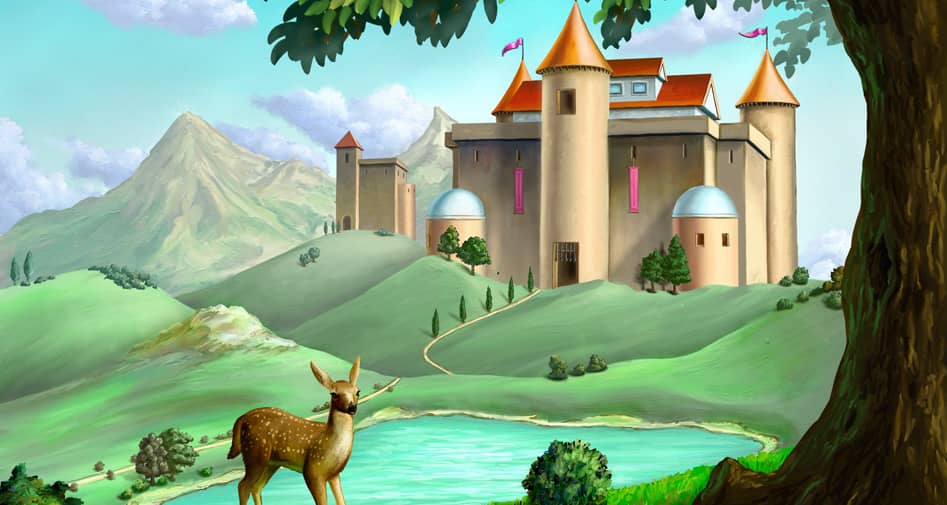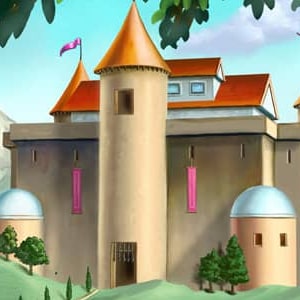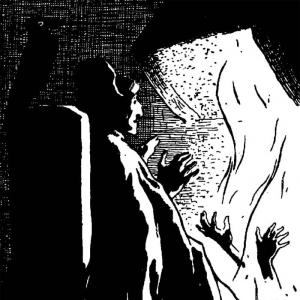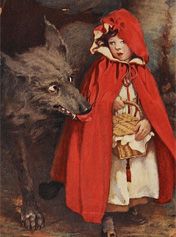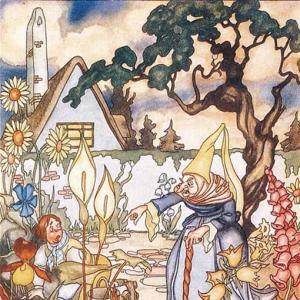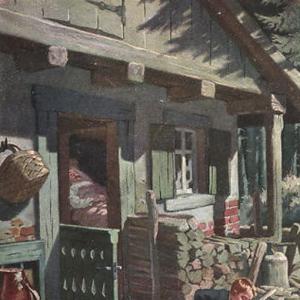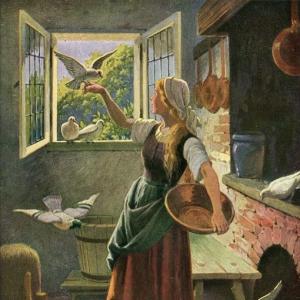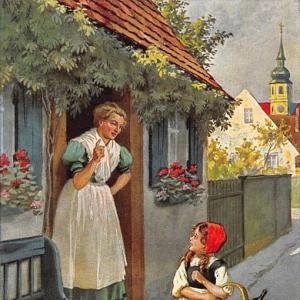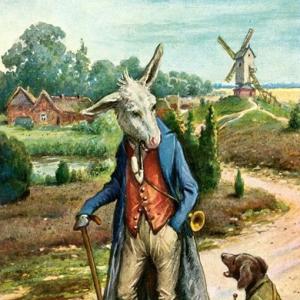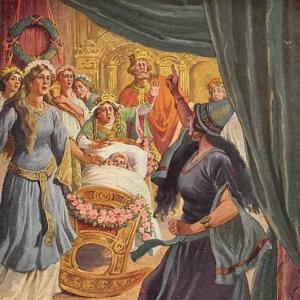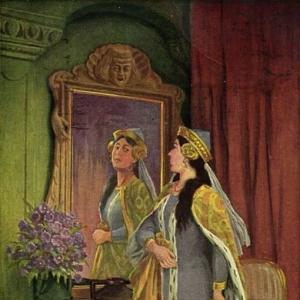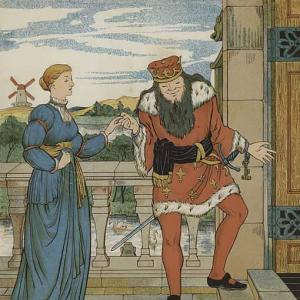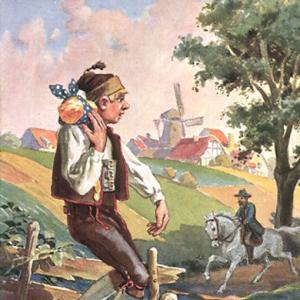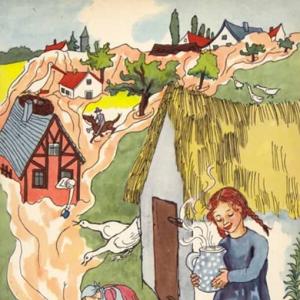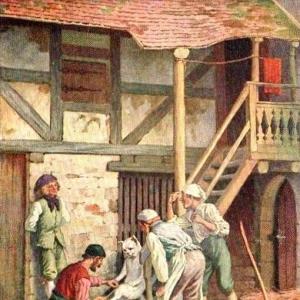Reading time for children: 11 min
Out in the country there was an old mansion where an old squire lived with his two sons, who were so witty that they thought themselves too clever for words. They decided to go out and propose to the King’s daughter, which they were at liberty to do, for she had announced publicly that she would take for a husband the man who had the most to say for himself.
The two brothers made their preparations for eight days beforehand. That was all the time they had, but it was enough, for they had many accomplishments, and everyone knows how useful they can be. One of them knew the whole Latin dictionary by heart and the town’s newspaper for three years – so well that he could repeat it backward or forward. The other had learned all the articles of law and knew what every alderman must know; consequently, he was sure he could talk of governmental affairs, and besides this he could embroider suspenders, for he was very gentle and also clever with his fingers.
„I shall win the Princess!“ they both said, as their father gave each one of them a beautiful horse. The one who had memorized the dictionary and the newspapers had a coal-black horse, while the one who knew all about governmental affairs and could embroider had a milk-white one. Then they smeared the corners of their mouths with cod-liver oil, to make them more glib.
All the servants assembled in the courtyard to watch them mount their horses, but just then the third brother came up. For there were really three, although nobody paid much attention to the third, because he was not so learned as the other two. In fact, everybody called him „Clumsy Hans.“
„Where are you going in all your Sunday clothes?“ he asked.
„To the King’s court, to woo the Princess. Haven’t you heard what the King’s drummer is proclaiming all over the country?“ Then they told him about it.
„Gracious,“ said Clumsy Hans, „I guess I’ll go, too!“ But his brothers only burst out laughing at him as they rode away.
„Father,“ shouted Clumsy Hans, „Let me have a horse. I feel like getting married, too. If she takes me, she takes me; and if she doesn’t take me, I’ll take her, anyway.“
„That’s a lot of nonsense!“ replied his father. „You’ll get no horse from me. Why, you don’t know how to talk properly. Now, your brothers are intelligent men.“
„If I can’t have a horse I’ll take the billy goat,“ said Clumsy Hans. „He belongs to me, and he can carry me very well.“ So he mounted the billy goat, dug his heels into its sides, and galloped off down the highway.
„Alley-oop! What a ride! Here I come!“ shouted Clumsy Hans, singing so loud that his voice was heard far away.
But his two brothers rode quietly on ahead of him. They were not speaking a word to each other, for they were thinking about all the clever speeches they would have to make, and of course these had to be carefully prepared and memorized beforehand.
„Halloo!“ cried Clumsy Hans. „Here I come! Look what I found on the road!“ Then he showed them a dead crow he had picked up.
„Clumsy!“ said the brothers. „What are you going to do with that?“
„Why, I am going to give it to the Princess!“
„Yes, you do that,“ they said as they rode on laughing.
„Halloo, here I come again! Just look what I’ve found this time! You don’t find things like this in the road every day!“ So the brothers turned around to see what it was this time.
„Clumsy!“ they said. „That’s just an old wooden shoe, and the upper part’s broken off, anyway. Is the Princess going to have that, too?“
„She certainly is,“ replied Hans, and the brothers again laughed and rode on far in advance of him.
„Halloo! Here I am again,“ shouted Clumsy Hans. „Now this is getting better and better! This is really something!“
„Well, what have you found this time?“ asked the brothers.
„Oh, I can’t really tell you,“ Clumsy Hans said. „How pleased the Princess will be!“
„Uh!“ said the brothers. „Why, it’s nothing but mud out of the ditch!“
„Yes, of course,“ said Clumsy Hans, „but the very finest sort of mud. Look, it runs right through your fingers.“ Then he filled his pockets with it.
But his brothers galloped on ahead as fast as they could, and so they arrived at the town gate a full hour ahead of Hans. At the gate each suitor was given a numbered ticket, and as fast as they arrived they were arranged in rows, six to a row, packed together so tightly that they could not even move their arms. That was a wise plan, for otherwise they could have cut each other’s backs to pieces, just because one stood in front of another. All the inhabitants of the town stood around the castle, peering in through the windows to watch the Princess receive her suitors; but as each young man came into the room, he became tongue-tied.
„No good!“ said the Princess. „Take him away!“
Now came the brother who had memorized the dictionary, but he had completely forgotten it while standing in line. The floor creaked under his footsteps, and the ceiling was made of mirrors so that he could see himself standing on his head; and at each window stood three clerks and an alderman, writing down every word that was spoken, so that it immediately could be printed in the newspapers and sold for two pennies on the street corners.
It was a terrible ordeal, and besides there were such fires in the stoves that the pipe was red-hot.
„It’s terribly hot in here,“ said the suitor.
„That’s because my father is roasting chickens today,“ said the Princess.
„Baa!“ There he stood. He was not ready for a speech of this kind and hadn’t a word to say, just when he wanted to say something extremely witty. „Baa!“
„No good!“ said the Princess. „Take him away!“ And consequently he had to leave.
Now the second brother approached.
„It’s dreadfully warm here,“ he said.
„Yes, we’re roasting chickens today,“ replied the Princess.
„What-what did you-uh-what?“ he stammered, and all the clerks carefully wrote down, „What-what did you-uh-what?“
„No good,“ said the Princess again. „Out with him!“
Now it was Clumsy Hans’s turn, and he rode his billy goat right into the hall.
„Terribly hot in here,“ he said.
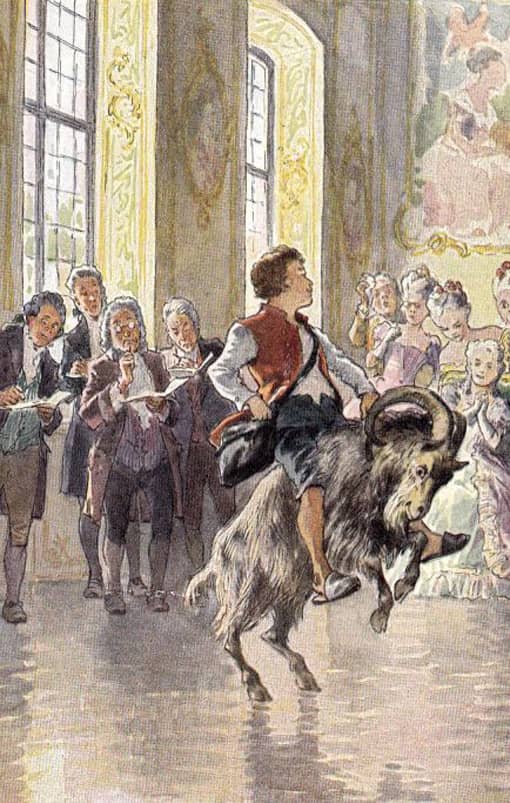
„I’m roasting young chickens,“ replied the Princess.
„Why, that’s fine!“ said Clumsy Hans. „Then I suppose I can get my crow roasted?“
„That you can,“ said the Princess. „But have you anything to roast it in? I haven’t any pots or pans.“
„But I have,“ replied Clumsy Hans. „Here’s a cooking pot with a tin handle!“ Then he pulled out the old wooden shoe and put the crow right into it.
„Why, that’s enough for a whole meal!“ said the Princess. „But where do we get the sauce from?“
„I have that in my pocket,“ replied Clumsy Hans. „In fact, I have so much I can afford to spill some of it.“ Then he poured a little of the mud from his pocket.
„I like that!“ said the Princess. „You have an answer for everything, and you know how to speak. I’ll take you for my husband. But do you know that everything we’ve said and are saying is written down and will be published in the paper tomorrow? Look over there, and you’ll see in each window three clerks and an old alderman, and that alderman is the worst of all. He doesn’t understand anything!“
She said this only to frighten him, but all the clerks chuckled with delight and spurted blots of ink on the floor.
„Oh, so these are the gentlemen!“ said Clumsy Hans. „Then I must give the alderman the best thing I have.“ Then he turned out his pockets and threw the wet mud in the face of the alderman.
„Cleverly done!“ said the Princess. „I could never have done that, but I’ll learn in time!“
So Clumsy Hans was made a king, with a wife and a crown, and sat on a throne. And we had this story straight from the alderman’s newspaper-but that is one you can’t always depend upon.
 Learn languages. Double-tap on a word.Learn languages in context with Childstories.org and Deepl.com.
Learn languages. Double-tap on a word.Learn languages in context with Childstories.org and Deepl.com.Backgrounds
Interpretations
Adaptions
Summary
Linguistics
„Clumsy Hans“ (also known as „Clumsy Jack“ or „Dull Jack“) is a fairy tale by the famous Danish author Hans Christian Andersen, who is best known for his classic stories like „The Little Mermaid,“ „The Ugly Duckling,“ and „The Emperor’s New Clothes.“ Andersen was born in Odense, Denmark, in 1805 and published his first collection of fairy tales, „Fairy Tales Told for Children,“ in 1835.
Andersen’s fairy tales are known for their fantastical elements, moral lessons, and exploration of human emotions and experiences. His stories often feature underdogs or unlikely heroes who triumph over adversity, as is the case with Clumsy Hans. Andersen’s stories have been translated into more than 100 languages and have been adapted into numerous films, plays, and musicals, ensuring their enduring popularity.
„Clumsy Hans“ was first published in the early 1850s as a part of one of Andersen’s fairy tale collections. The story is not as widely known as some of Andersen’s other works, but it remains a charming and engaging tale that highlights the importance of self-expression, authenticity, and unconventional intelligence. Like many of Andersen’s stories, „Clumsy Hans“ has been retold and adapted in various forms, including children’s books and theatrical productions.
„Clumsy Hans“ can be interpreted in various ways, offering insights into themes such as intelligence, self-expression, and authenticity. Here are some interpretations of the fairy tale:
Unconventional intelligence: The story highlights that intelligence comes in different forms. While the two older brothers are book-smart, Clumsy Hans possesses a different kind of intelligence. His creativity, resourcefulness, and quick wit help him win the Princess’s heart, demonstrating that one does not need to be traditionally smart to succeed in life.
Importance of self-expression: The King’s daughter values the ability to express oneself effectively. Clumsy Hans’s unique and unorthodox way of expressing himself ultimately impresses the Princess, showing that genuine self-expression can be more appealing than rehearsed speeches or conventional displays of knowledge.
Authenticity and originality: Clumsy Hans’s authenticity and originality set him apart from the other suitors. Instead of trying to impress the Princess with traditional methods, he stays true to his quirky nature and uses unconventional means to win her over. This highlights the importance of being true to oneself and embracing one’s individuality.
Humor and light-heartedness: The story emphasizes the value of humor and light-heartedness in life. Clumsy Hans’s ability to make the Princess laugh and enjoy herself plays a significant role in his success. This interpretation suggests that sometimes, laughter and a light-hearted attitude can be more important than intellectual prowess.
Reliability of sources: The story concludes by questioning the reliability of the alderman’s newspaper, which provided the tale. This could be a commentary on the importance of critical thinking and being discerning about the sources of information one relies on.
Overall, „Clumsy Hans“ offers valuable lessons about the different forms of intelligence, the significance of self-expression and authenticity, and the importance of humor and light-heartedness in life. It also serves as a reminder to question the reliability of sources and practice critical thinking.
„Clumsy Hans“ has been adapted in various forms over the years, including in literature, film, and theater. Here are a few examples.
„The Ugly Duckling“ (animated film, 1931): This animated film by Walt Disney Studios features the story of „The Ugly Duckling,“ which is based on the same Hans Christian Andersen tale that inspired „Clumsy Hans.“ Although not a direct adaptation of „Clumsy Hans,“ the film shares similar themes of perseverance and the value of inner beauty.
„Hans“ (musical, 2005): „Hans“ is a musical adaptation of „Clumsy Hans“ that was written by playwright and composer Michael John LaChiusa. The musical premiered at the New York Musical Theater Festival in 2005 and has since been performed in various theaters around the world.
„Clumsy Hans“ (picture book, 2018): In this picture book adaptation of the tale by Jan Brett, Hans is portrayed as a young bear who is teased by the other animals in his forest for his clumsiness. Like the original story, Hans eventually wins over the other animals through his kindness and helpfulness.
„The Clumsy King“ (picture book, 2006): In this retelling of the tale by Andrea U’Ren, the character of Hans is replaced by a king who is known for his clumsiness. The story follows the king as he attempts to find a bride who will accept him despite his flaws.
Overall, „Clumsy Hans“ has been adapted in various ways over the years, each emphasizing different aspects of the original story. From picture books to musicals, these adaptations continue to bring the timeless themes of perseverance and inner beauty to new audiences.
„Clumsy Hans“ is a fairy tale by Hans Christian Andersen that revolves around an old squire and his three sons, two of whom are considered very intelligent and one, Clumsy Hans, who is not. The King’s daughter announces that she will marry the man who can best express himself, and the two intelligent brothers prepare to win her hand. They receive horses from their father, but Clumsy Hans is denied a horse and rides a billy goat instead.
The brothers set off, and Clumsy Hans picks up strange items along the way, including a dead crow, a broken wooden shoe, and mud from a ditch. His brothers laugh at him, but he insists on presenting these items to the Princess. At the castle, each suitor receives a numbered ticket and is arranged in rows to meet the Princess. The brothers, who have memorized speeches, become tongue-tied and fail to impress the Princess.
Clumsy Hans enters the hall on his billy goat, and the Princess tells him they are roasting chickens. He asks if his crow can be roasted, producing the wooden shoe as a cooking pot and the mud as a sauce. The Princess is amused by his resourcefulness and ability to converse, and she accepts him as her husband. Clumsy Hans becomes a king, and the tale concludes by questioning the reliability of the source, the alderman’s newspaper.
The fairy tale „Clumsy Hans“ by Hans Christian Andersen is characterized by its humor, satire, and inversion of traditional fairy tale tropes. A linguistic analysis of the text reveals several key elements that contribute to its storytelling.
Characterization through Dialogue: The dialogue in the story plays a critical role in developing characters. The two learned brothers speak in a pompous and condescending manner, which marks their elevated social status and self-importance. In contrast, Clumsy Hans speaks in a straightforward, colloquial style, highlighting his simplicity and lack of pretension.
Use of Irony and Satire: Andersen employs irony and satire to critique societal norms, particularly the value placed on education and eloquence. The two learned brothers, despite their extensive knowledge, are rendered speechless in the presence of the Princess. This contrasts with Clumsy Hans, whose lack of formal knowledge and simplicity becomes his greatest asset, allowing him to win the Princess’s favor.
Repetition for Emphasis: The story uses repetition, particularly with Clumsy Hans’s repeated exclamations of „Halloo! Here I come!“ This repetition serves to emphasize his carefree and joyful nature, contrasting with the seriousness of his brothers. It also adds a rhythmic and playful element to the narrative.
Subversion of Expectations: Andersen subverts traditional expectations by making Clumsy Hans, the least likely candidate, succeed where the learned brothers fail. Linguistically, this is achieved by contrasting the brothers‘ complex preparations with Hans’s spontaneous actions and dialogue, highlighting the absurdity of over-preparation.
Humor and Playfulness: The language in the tale is infused with humor and playfulness. This is evident in the absurdity of Clumsy Hans’s „gifts“ to the Princess, such as a dead crow, a broken shoe, and mud, and in his humorous interactions with the Princess. The playful tone is maintained through the witty exchanges and Hans’s unorthodox solutions to problems.
Narrative Voice and Reliability: The story concludes with a nod to the unreliability of the narrative source, stating that the story comes from the alderman’s newspaper, „but that is one you can’t always depend upon. “ This meta-narrative comment adds a layer of complexity, prompting readers to question the authenticity and authority of written records.
Overall, Andersen’s linguistic choices in „Clumsy Hans“ work together to create a lighthearted, satirical tale that critiques societal values and celebrates simplicity and authenticity over pretension and learnedness.
Information for scientific analysis
Fairy tale statistics | Value |
|---|---|
| Translations | DE, EN, DA, ES, FR, IT, NL |
| Readability Index by Björnsson | 24.7 |
| Flesch-Reading-Ease Index | 86.2 |
| Flesch–Kincaid Grade-Level | 3.9 |
| Gunning Fog Index | 6.5 |
| Coleman–Liau Index | 8.7 |
| SMOG Index | 7.7 |
| Automated Readability Index | 3.5 |
| Character Count | 7.824 |
| Letter Count | 5.867 |
| Sentence Count | 132 |
| Word Count | 1.411 |
| Average Words per Sentence | 10,69 |
| Words with more than 6 letters | 198 |
| Percentage of long words | 14% |
| Number of Syllables | 1.831 |
| Average Syllables per Word | 1,30 |
| Words with three Syllables | 79 |
| Percentage Words with three Syllables | 5.6% |
